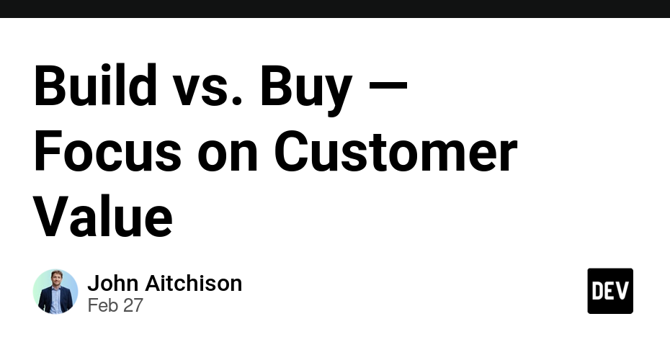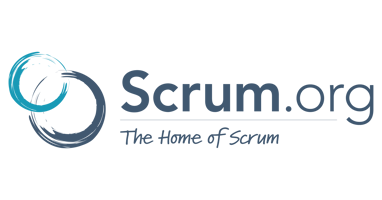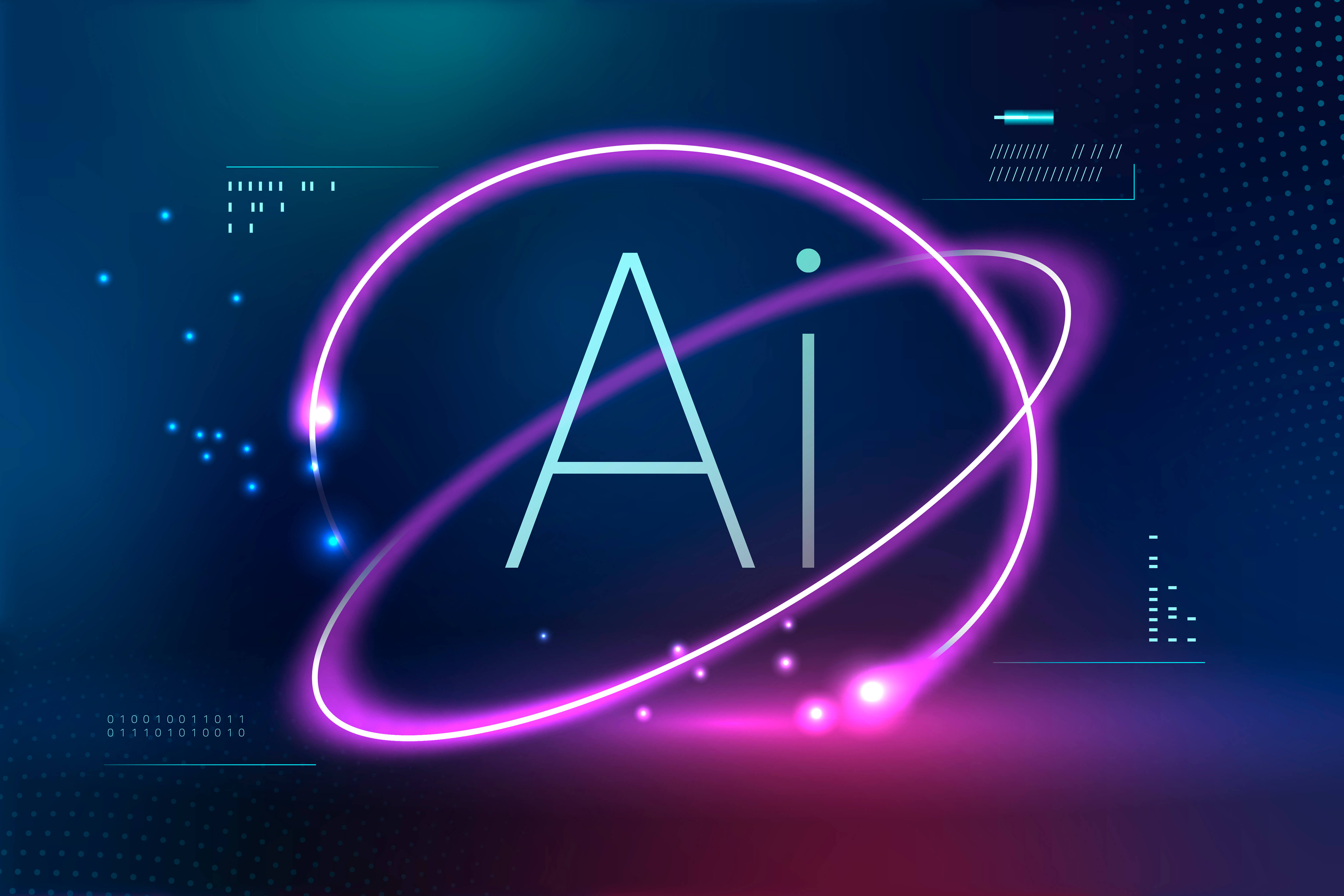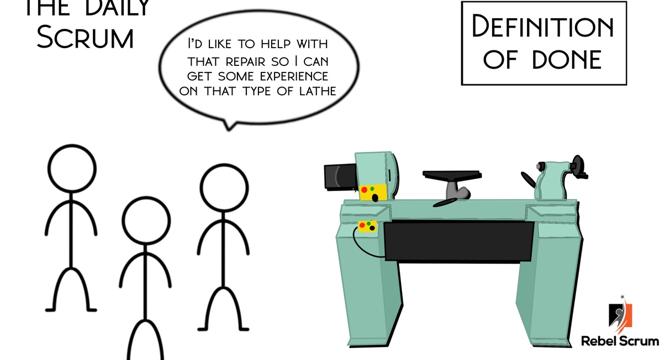Agile Methodology News
Scrum
318

Image Credit: Scrum
Are You Inspecting to Adapt or Just Showcasing?
- The Scrum Team and its stakeholders inspect the results and adjust for the next Sprint.
- Sprint Reviews are not about showcasing work, but discovering how to evolve the product.
- Inspecting without adapting is just theater.
- The focus is on gathering insights from stakeholders and their experiences with the product.
Read Full Article
19 Likes
Dev
428

Image Credit: Dev
Build vs. Buy — Focus on Customer Value
- When deciding whether to build or buy software applications, it is important to consider the primary value it will bring to customers.
- If the primary value is already provided by an existing open-source component/library, it may be more beneficial to implement that rather than building it from scratch.
- On the other hand, if building a custom feature is highly valuable and aligns with the expertise of the engineering team, it may be worth the investment.
- Ultimately, the decision should be based on the value it will bring to customers and the comparative advantages of each option.
Read Full Article
25 Likes
Scrum
432

Image Credit: Scrum
Beyond ‘Fail Fast’: A Smarter Approach to Innovation
- The traditional approach of 'fail fast' and 'move fast and break things' in innovation may not be effective in most situations as it often avoids managing risk, thinking strategically, being transparent, and taking responsibility.
- A smarter approach involves 'failing smarter,' which means treating failures as learning opportunities by having clear hypotheses, measuring specific outcomes, and building systematic understanding.
- Additionally, 'failing sooner' emphasizes timing and risk assessment in experiments to manage investment risk, reduce potential negative impacts, and gain valuable insights for the next iteration.
- The concept of 'failing forward' suggests using each experiment as a chance to learn, make progress, and adjust goals based on the information gained, treating measures and results neutrally.
Read Full Article
26 Likes
Scrum
382

Image Credit: Scrum
6 Must-Know Concepts to Build a Winning Product Operating Model
- A product operating model defines how a company structures, funds, and runs its product organisation to effectively deliver business outcomes.
- Key components of a product operating model include product strategy & vision, team structure & roles, funding & governance, decision-making & autonomy, ways of working & execution, and measurement & success metrics.
- Product strategy & vision outline the long-term direction and align efforts with business goals.
- Team structure & roles focus on empowered teams, cross-functional collaboration, and decentralized product management.
Read Full Article
23 Likes
Discover more
- Programming News
- Software News
- Web Design
- Devops News
- Open Source News
- Databases
- Cloud News
- Product Management News
- Operating Systems News
- Computer Engineering
- Startup News
- Cryptocurrency News
- Technology News
- Blockchain News
- Data Science News
- AR News
- Apple News
- Cyber Security News
- Leadership News
- Gaming News
- Automobiles News
Scrum
9

Image Credit: Scrum
The Empathetic Leadership
- Empathy is defined as the ability to imagine how another person is feeling and understand their mood.
- There are three types of empathy: cognitive empathy, emotional empathy, and compassionate empathy.
- Empathy in leadership improves self-awareness, listening skills, mentoring abilities, and creates a supportive environment for employees.
- Empathy is essential for building trust, collaboration, positive organizational culture, and supporting employee mental health.
Read Full Article
Like
Hackernoon
41

Image Credit: Hackernoon
If a Task Does Not Directly Contribute to the Company’s Goals, It’s Wasted Effort
- Product managers often encounter Agile and Scrum terminologies, with Scrum sometimes hindering creativity in developers.
- Scrum entails two-week sprints where PMs prioritize tasks and manage backlogs to keep the team on track.
- Addressing Scrum's limitations with a human-centered approach is crucial for enhancing productivity.
- Balancing time and momentum is essential in Scrum, emphasizing breaking tasks into manageable pieces rather than extending sprints.
- Engineers benefit from self-imposed deadlines to stay accountable and refine their estimations.
- PMs need to be cautious about workload distribution to prevent burnout and missed deadlines among engineers.
- Ensuring developers understand the business context behind their work can enhance engagement and innovation.
- A well-structured roadmap should align every task with the larger product vision to prevent wasted effort.
- Ideally, product managers ensure the team focuses on high-impact work that aligns with strategic objectives.
- PMs play a vital role in managing long-term sustainability and energizing the team for continuous innovation.
- Leading with empathy, understanding team dynamics, and creating an engaging work environment are key aspects of successful Scrum implementation.
Read Full Article
2 Likes
Kanbanzone
364

Image Credit: Kanbanzone
Weekly Planning: Improvements and Unplanned Work – I Bought A House
- The author shares their experience of finding and buying a house in Canada, documenting the process in their Weekly Plan card.
- After a virtual visit, they made an offer with certain conditions and organized all related information on the card.
- They stored house details, documents, and created checklists to manage tasks like measurements and financial arrangements.
- Using cloud storage for file sharing, they avoided revealing the Kanban board to collaborators but ensured document collaboration.
- The author emphasizes the benefits of using Kanban to consolidate work information and reduce reliance on emails and meetings.
- They describe improvements in managing weekly cards, focusing on setting weekly goals, tasks, and recurring templates.
- The card template includes sections for weekly priorities, maintaining tasks per role, recurrence settings, and relative start and end dates.
- Thanks to detailed planning, the author efficiently completed tasks related to buying the house, while still managing other commitments.
- Their Weekly Planning Series highlights gradual improvements in planning and task management over different weeks.
Read Full Article
21 Likes
Alvinashcraft
86

Image Credit: Alvinashcraft
Dew Drop – February 27, 2025 (#4371)
- GitHub Copilot now includes Terminal Chat for free. The Phi family is introducing the next generation innovations. OpenAI and Angular enable AI-Assisted Mind Mapping with interactive diagrams.
- Dev Proxy v0.25 is released with automatic shutdown and simplified configuration management. Warp, the intelligent terminal, is now available on Windows.
- Azure NetApp Files is transforming silicon design for high-performance computing. A shoutout component is built in HTML/CSS/JavaScript. The Azure SDK for February 2025 has been released.
- Blazor WebAssembly Authentication and faster Go maps with Swiss Tables are discussed. Microsoft Edge Add-ons developers are empowered with faster reviews.
- OpenTelemetry Metrics and Inline Confirmations in JavaScript UI are explained. There are updates on the WordPress fight over trademarks and open source.
- C# Dev Kit is previewing .NET Aspire Orchestration. Okta Sign-In Experience customization is detailed. Node v23.9.0 (Current) is released.
- Building a stunning Music Track UI with .NET MAUI ListView is highlighted. Visual Studio 2022 Version 17.13.2 Release Notes are available.
- Converting MS Word DOCX to PDF with Form Fields in C# .NET and insights on C++/WinRT implementation inheritance are provided. WinUI, WPF, WinForms, UWP, and MFC are compared.
- Amazon introduces Alexa+ as 'model agnostic' and offers it for $19.99. Various AI topics like Pose Estimation, Azure OpenAI Assistants, and Azure AI Agent Services are covered.
- A guide on RAG Time and creations like GitHub Copilot-Code referencing are explored. Terraform and Azure DevOps automation and platform building pillars are discussed.
- Mobile development includes building a better developer experience and creating an interactive Heat Map with Flutter Charts. Podcasts and community events in AI innovation are showcased.
Read Full Article
5 Likes
Medium
350

Image Credit: Medium
The Epic Ownership Model : A Product Manager’s guide to rethinking team structure and driving…
- Introduction of the Epic ownership model can empower developers to take ownership of Epics within the team, fostering a sense of ownership and enhancing collaboration.
- This model allows developers to go beyond executing tasks and take a more proactive role in the product development lifecycle.
- Product managers can transition into strategic leadership roles by empowering developers to take ownership, allowing them to focus on defining product strategy.
- Teams that have implemented the Epic Ownership model have experienced benefits such as proactive issue tracking and improved client communication.
Read Full Article
21 Likes
Scrum-Master-Toolbox
396

Season Hughes: How To Be A Data-Driven Scrum Master Or Agile Coach
- Season Hughes highlights the importance of being a data-driven Scrum Master or Agile Coach.
- She emphasizes the significance of regularly referring back to the Scrum Guide and measuring progress against its principles.
- Collecting data and measuring indicators like self-management is crucial, which can be assessed by observing team autonomy.
- Season recommends the Lean Coffee format for retrospectives to increase engagement and ownership.
Read Full Article
23 Likes
Testim.io
209

Image Credit: Testim.io
Revolutionizing Software Testing: The Power of AI in Action
- Software testing with AI involves using artificial intelligence to assist QA testers, improving test coverage and efficiency.
- AI plays a role in various stages of the software testing lifecycle, from requirement analysis to test closure.
- Tasks like test data generation, self-healing tests, regression test selection, and predictive analytics benefit from AI.
- The benefits of AI in software testing include cost reduction, consistency, early defect detection, swift feedback, and high-quality test cases.
- However, drawbacks of using AI in testing include biases, lack of data for training, high initial costs, privacy concerns, and maintenance challenges.
- AI in software testing is not a replacement for human testers but complements their work, enhancing testing processes.
- AI tools like Tricentis Testim and Tosca leverage AI to improve software quality and accelerate release cycles.
- Organizations should carefully consider the advantages and limitations of AI in testing to make informed decisions about integration.
- As the industry continues to explore AI capabilities, the potential for enhancing the software testing landscape remains promising.
Read Full Article
12 Likes
Dev
95

Image Credit: Dev
Whoever has come up with the term "Scrum master" should have seen developers as "Scrum slaves"! 🛑 ✋
- The term 'Scrum master' may have been coined with good intentions, envisioning a leader who guides and empowers development teams.
- However, the reality for many developers often seems more akin to being 'Scrum slaves.' The misuse of Scrum as a mere daily report mechanism rather than a tool for effective planning and continuous learning has led to frustration and dissatisfaction among many in the developer community.
- The discontent has manifested in individuals abandoning programming or transforming their roles from technical person to Scrum master.
- Many believe that the misuse of Scrum has turned it into a traditional managerial tool focused on meetings and daily reporting rather than collaboration, flexibility, and continuous improvement.
Read Full Article
5 Likes
Medium
127

Image Credit: Medium
Facilitator’s Notes — Drone Mystery
- Crunching the numbers can be a very important part of a Product Manager or Product Owners job.
- Participants should consider how they might roll out their chosen product incrementally, starting with a basic version and refining it based on customer input.
- Participants must evaluate the three options based on budget, resources, and potential ROI, deciding which one offers the most value with the least effort.
- This scenario can play out over 45 minutes to an hour with a group.
Read Full Article
7 Likes
Scrum
27

Image Credit: Scrum
Scrum Teams - the practices that lead to anti-patterns and their impact
- Wrong practices associated with Scrum can often lead to anti-patterns within Scrum Teams.
- Using a 3-question template for Daily Scrum can cause loss of focus, siloed vision, lack of commitment, and no collective ownership.
- Having a Sprint Goal that overlaps with the scope of work leads to unclear objectives, individual focus, lack of scope negotiation, and calling Sprint Failure prematurely.
- Implementing a rigid Definition of Ready can create a phase gate, reduce shared understanding, and give a false sense of clarity.
- Overemphasis on User Stories can result in mismatched expectations, lack of clarity, and an obsession with the format rather than focusing on value.
- The presence of a Proxy Product Owner can lead to delayed decision-making, lack of transparency, wasted time, increased rework, and delayed value delivery.
- The concept of Sprint Zero, which doesn't result in a valuable increment, can lead to a waterfall-like approach, be unrealistic, and lack empiricism.
- Teams should reflect on their practices regularly to ensure effectiveness and address anti-patterns to make Scrum Teams more productive.
- Encouraging Scrum teams and Scrum Masters to be aware of these pitfalls can help in enhancing the effectiveness of Scrum practices.
- It is essential to focus on continuous improvement and challenge existing practices to prevent ineffective Scrum implementations.
- For further insights on anti-patterns and improving Scrum teams, connecting with experts or visiting relevant websites can be beneficial.
Read Full Article
1 Like
Scrum
223

Image Credit: Scrum
Scrum in a Machine Shop
- Maintenance team at Argus, responsible for 60 CNC machines, faced challenges with workload management and process inconsistencies.
- To address these challenges, Maintenance Manager Brayden Yundt introduced Scrum framework, implementing a one-week sprint cycle and a refining meeting to prioritize projects.
- The team found benefits in the Daily Scrum and the team's ownership of the Definition of Done, improving task alignment, balancing planned and unplanned work, and setting standards for repairs.
- Scrum-based maintenance system has resulted in a more accountable, communicative, and efficient team, leading to plans of expanding the approach to other locations.
Read Full Article
13 Likes
For uninterrupted reading, download the app